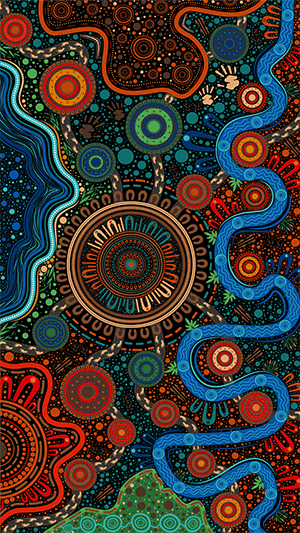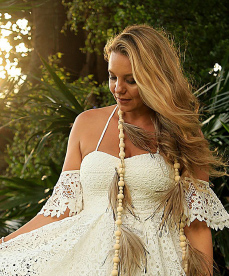Closing the Gap review
Yindyamarra ‘Connection’
About the artwork – Yindyamarra ‘Connection’
By Lani Balzan

The artwork titled Yindyamarra ‘Connection’ was created for the Productivity Commission’s visual identity for the first review of progress under the National Agreement on Closing the Gap.
The artwork design I created was to represent all Australians and Torres Strait Islander people and the lands together. Building and making decisions together to help Close the Gap between our cultures. My belief is that we can work together to help make changes by allowing all to be included in decision making. One can carry in their normal and usual way without ever making change because it works at the time. Sometimes we need to look at different ways and think outside of the box to make changes and let other voices be heard allowing many different perspectives to be viewed.
Our Aboriginal culture has always been sacred but never embraced by majority of non-indigenous people. In previous years there was limited public education as there is today to help Close the Gap between our people and Non-Indigenous people.
Throughout the artwork I have created specific elements and symbols to tell the story.
These are:
Centerpiece
The gathering symbol represents ‘Coming Together’ where members of Aboriginal communities come together for various purposes, such as cultural celebrations, ceremonies, storytelling, meetings, or important discussions. It represents the Productivity Commission as a whole centering Aboriginal and Torres Strait Island people and building stronger partnerships and trust.
- The outer blue and orange lines and dots represent data from communities allowing government to build stronger partnerships and trust.
- The U shape symbol represents people, showing all people including government in one place working together to make change.
- The three rings with dots represent Transformation of Government, these connect off the pathways.
Pathways
The pathways represent one will take to. All of these pathways join up to Aboriginal and Torres Strait Islander communities representing connection to culture and voices.
Country Elements
These are represented in 5 ways from land to sea which include two main elements representing Aboriginal People coming together, and the sea representing the connection to Torres Strait Islander people. The other elements are the connection to our rivers, mountains, land. Each element also includes smaller elements around them such as native plants, animal tracks, people gathering along the river, and water holes.
Communities
The communities for both Aboriginal and Torres Strait Islander people is represented in 20 different dotted circle symbols. The are broken up with orange, red and brown coloured symbols representing Aboriginal communities and the green and blues representing Torres Strait Islander communities.
Hands
The hands representing Indigenous and Non-Indigenous people working together Closing the Gap.
Kangaroo Tracks
The kangaroo tracks represent all people moving forward to make change. The Kangaroo is and native animal that is important to Aboriginal people and is known for always moving forward and standing tall.
Emu Tracks
The Emu tracks represent another important native animal that roams our land. They are known for Food and Resources, Cultural Symbolism and Spiritual and Totemic Significance.
Boomerang
The boomerang is hunting tool that is known for throwing. It is thrown outwards which then returns. This symbolises in the artwork the use of information and knowledge by going out to learn and collect information which is then returned to help make positive change.
About the artist

Lani Balzan is an Aboriginal artist and graphic designer specialising in designing Indigenous canvas art, graphic design, logo design, Reconciliation Action Plan design and document design.
Lani is a proud Aboriginal woman from the Wiradjuri people of the three-river tribe. Her family originates from Mudgee but she grew up all over Australia and lived in many different towns starting her business in the Illawarra NSW and recently relocating to Mid-North Queensland.
In 2016 Lani was announced as the 2016 NAIDOC Poster Competition winner with her artwork ‘Songlines’. This poster was used as the 2016 NAIDOC theme across the country.
Lani has been creating Aboriginal art since 2013 and has continued success across the country. One of her biggest goals and inspirations with creating Aboriginal art is to develop a better connection to her culture and to continue to work towards reconciliation; bringing people and communities together to learn about the amazing culture we have here in Australia.